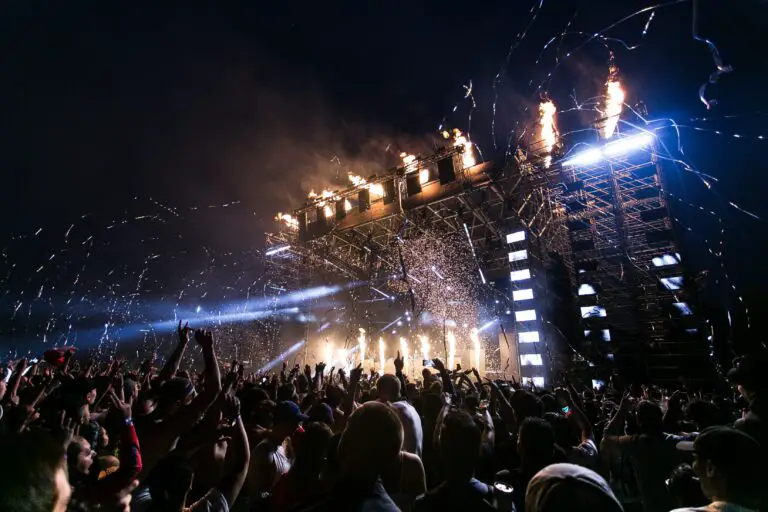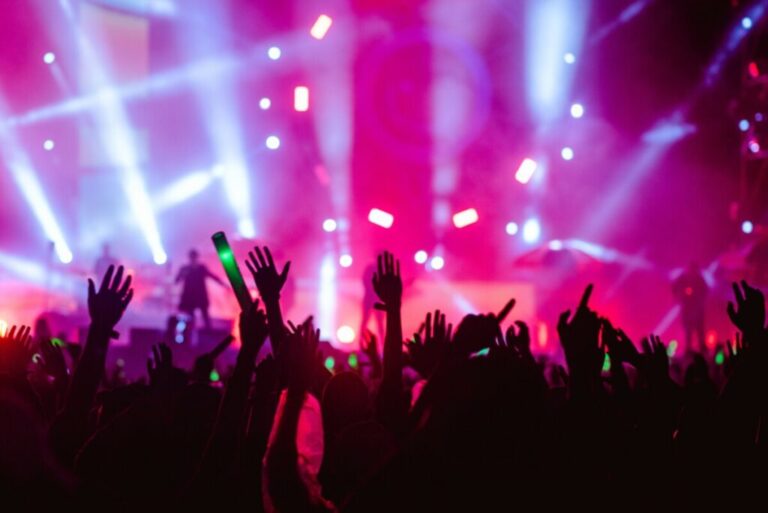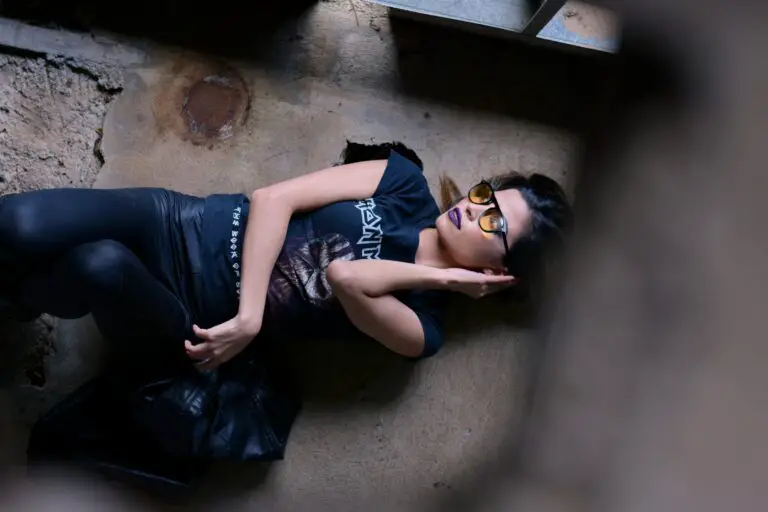Concert Terms Glossary: 54 Music Industry Definitions
Are you starting to get interested in music? If yes, there is some important terminology you should know in the music industry. Below, you’ll find 52 definitions in this concert terms glossary. If it helps you, please bookmark it for future reference!
1. Advance
In the context of concerts, “advance” typically refers to the period of time before a show or event takes place (advanced notice), during which tickets are available for purchase in advance of the performance date. Buying tickets can secure your spot for a concert.
Advanced ticket purchases offer better seating options or discounted prices compared to buying tickets at the door on the day of the concert. In addition, purchasing tickets in advance can help ensure you don’t miss out on a popular event, as some concerts may sell out quickly.
2. Backline
“Backline” refers to the musical equipment positioned at the back of the stage. Performers can use this equipment during the concert.
Backline equipment includes these items:
- Drums
- Amplifiers
- Keyboards
- Microphones
- Sound mixers
- Anything necessary for a show
The concert venue or promoter often provides a backline. Multiple performers may share it during a concert or festival.
Backline equipment helps performers have the gear to put on a great show, without transporting their own gear. It also provided a backup option to performers who prefer their gear.
3. Barricade
“Barricade” (like our website’s name) refers to a physical barrier between the stage and the audience. The barricade uses sturdy materials (like steel) to provide a clear separation between the performers and the audience.
The barricade helps keep the performers and the concert-goers safe. It can prevent fans from rushing to the stage or interfering with the performance. Sometimes, the barricade has security personnel to enforce the separation between fans and players.
4. Backstage
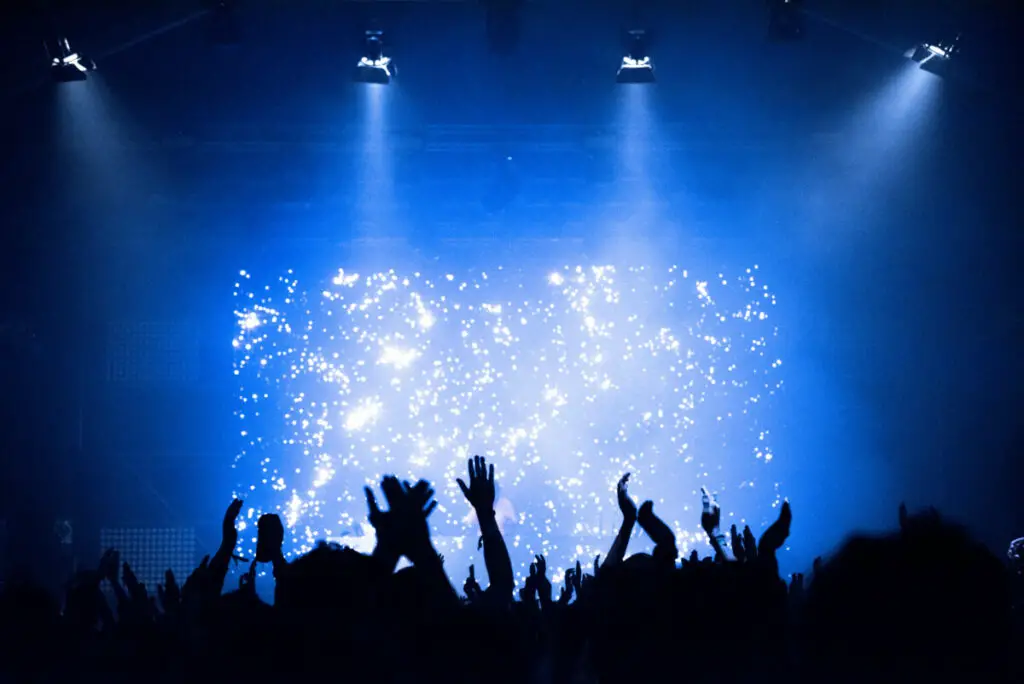
“Backstage” is the area of the concert venue only for performers and their support staff. This area is often behind the stage and may include dressing rooms, lounges, and other facilities the performers use before and after the show.
Backstage areas are usually off-limits to the general public. These areas may only be accessed by performers, crew members, and authorized personnel. The backstage can be a busy and high-energy environment, as performers prepare for their show, practice their routines, and interact with other team members.
5. Bonuses/Overages
Bonuses or overages refer to additional payments beyond an artist’s guaranteed fee. These payouts occur when artists meet or exceed certain performance milestones, such as selling out a show or making enough revenue for the venue.
These bonuses or overages are usually negotiated as part of the artist’s contract. They incentivize performers to work hard and promote their concerts to ensure success.
6. Bid/Offer
A bid or offer is the price a promoter or buyer will pay for an artist to perform at an event. This offer is negotiated between the buyer and the artist’s representatives.
- These factors influence the size of a bid:
- The artist’s popularity
- Recent performance history
- The size and location of the venue
- The expected attendance or revenue
The bid or offer represents the financial commitment that the buyer is willing to make to secure the artist’s services for the event.
7. Box Office Statement/ Ticket Manifest
A box office statement or ticket manifest is a document that provides information about event-based ticket sales. The ticketing company or venue typically generates this document.
The manifest includes these items:
- Total number of tickets sold
- Price of each ticket
- The date and time of each sale
- Any fees or taxes.
The box office statement or ticket manifest is an important tool for event organizers and promoters. It allows them to track the revenue generated by ticket sales and make informed decisions about future events.
8. Break Even Point
The break-even point is when the total revenue equals the total expenses for an event. In other words, it is when the event has neither made a profit nor incurred a loss.
The break-even point tells you how many tickets you must sell to start making money. Once you get to the “zero,” it’s all profit for the venue, artists, and anyone else entitled to a cut.
Concert promoters might adjust the ticket price based on projected sales. This way, you don’t have to sell as many tickets to reach this point. However, they risk losing sales if driving the ticket price too high.
9. Concert
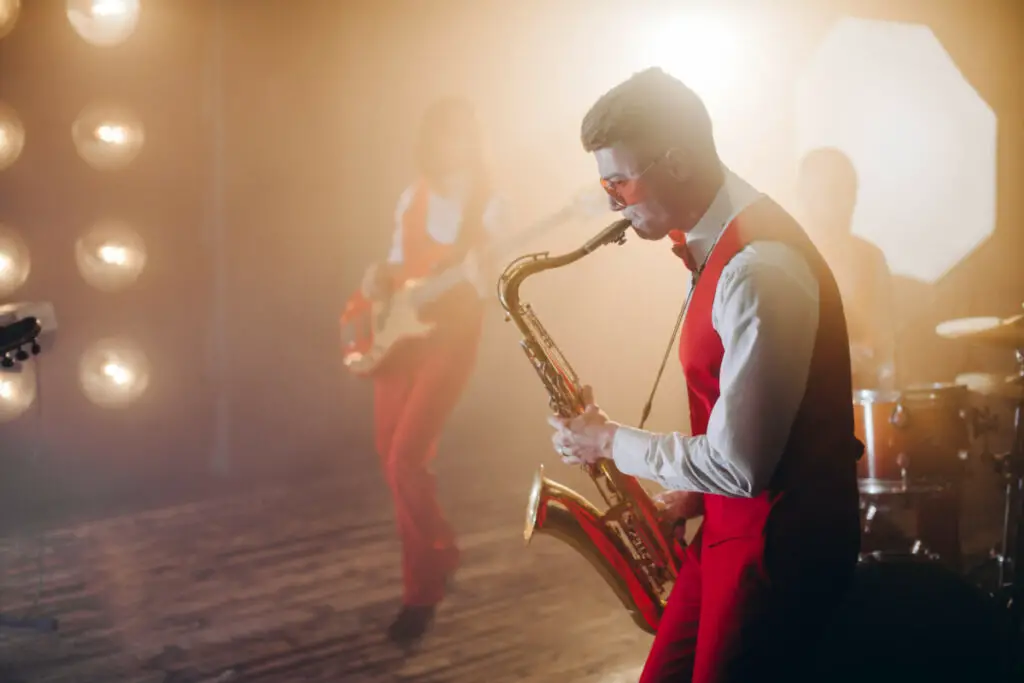
A concert is a live performance by one or more musicians, typically/hopefully in front of a paying audience. Concerts can be held in various venues, including theaters, clubs, arenas, and outdoor spaces.
Concerts are often organized and advertised by a promoter or production company. Tickets are sold to the public in advance of the performance. Concerts provide a unique opportunity for fans to see their favorite artists perform live and can be a powerful experience that creates lasting memories.
10. Configuration
Configuration is the physical arrangement of the stage, seating, and other elements within a venue. This includes these factors:
- Placement of the stage in relation to the seating area
- Size and shape of the stage
- The layout of the seating and aisles
- Location of additional features such as sound systems, lighting, and video screens.
a venue’s configuration can have a significant impact on the overall experience of the audience and the performance of the artists. Configurations may vary depending on the type of event and the preferences of the artist and production team.
11. Contract
A contract is a legally binding agreement between two parties. In our concert-centric definition list, this might include the artist and the promoter or venue. Either way, it outlines the terms and conditions of this professional relationship.
A concert contract includes details such as the date, time, and location of the event, the artist’s fee, any technical or logistical requirements, and the responsibilities of both parties.
Contracts may also include provisions related to insurance, liability, cancellation policies, and any additional terms negotiated between the parties. Concert contracts are important tools for protecting the artist and the promoter. Contracts are essential for ensuring concerts are planned and executed professionally and transparently.
12. Crew
A crew is a group that works behind the scenes to set up, operate, and maintain the technical aspects of the performance. This may include these roles:
- Sound engineers
- Lighting technicians
- Stagehands
- Riggers
- Other production personnel
The crew is responsible for everything from setting up the stage to running the sound and lighting during the performance. They are critical in ensuring the event runs smoothly, and the artist’s vision is realized.
Crew members often work long hours and in challenging conditions. Their expertise is invaluable in creating a successful concert.
13. Disclaimers
A disclaimer is a statement included in promotional materials, tickets, or other documents that limits the legal liability of the promoter, venue, or artist. Disclaimers warn attendees of the potential risks of attending the concert. These statements may state that the promoter, venue, or artist is not responsible for any injuries, damages, or losses during the event.
While disclaimers do not necessarily absolve parties of legal responsibility, they are an important tool for managing risk and protecting the interests of all parties involved in the concert production process.
14. Drop
A drop refers to a sudden change in the music or lighting during a performance. “The Drop” creates a dramatic effect or builds anticipation.
Beat drops are commonly used in electronic dance music (EDM). A drop may involve a sudden change in tempo, melody, or rhythm. You might also see a change in the lighting or visual effects on the stage.
Drops can create a sense of excitement throughout the audience. These drops can be a powerful tool for creating memorable moments during a concert performance.
15. Dressing Room
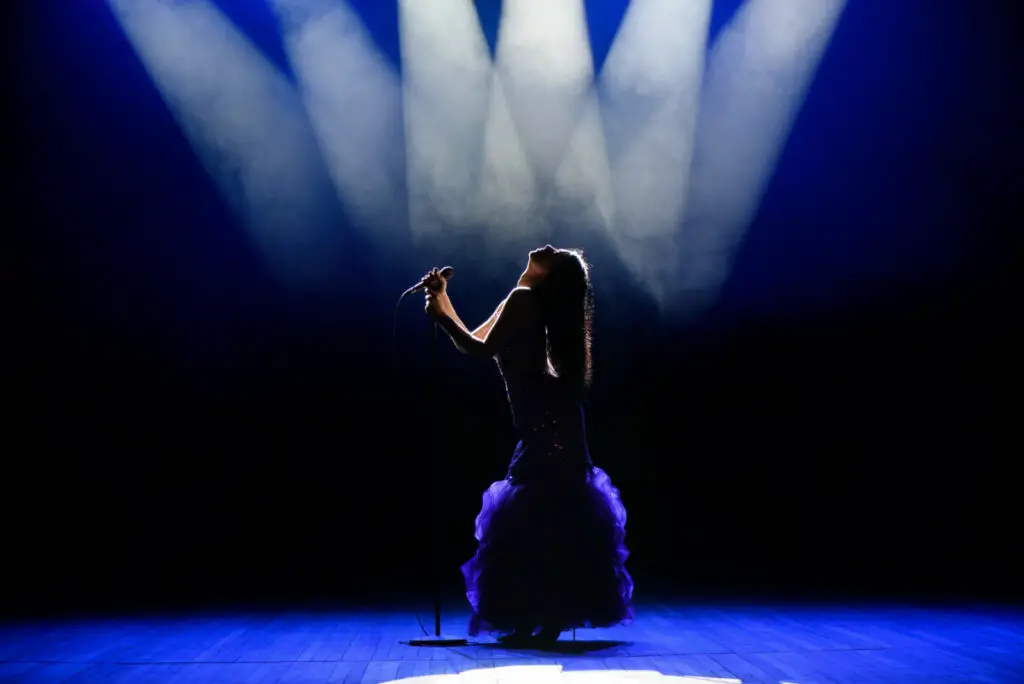
A dressing room is a private area backstage where performers prepare and store their personal belongings. Dressing rooms vary in size and amenities depending on the size and type of venue.
These rooms typically this as a bare minimum:
- Mirror
- Seating
- Dresser
- Additional storage
Dressing rooms provide performers a private space to focus and prepare without distractions. These rooms may also be a place for performers to rest and relax between performances or during breaks.
16. Encore
An encore is an additional performance after the main set of an artist or band. Encores are a long-standing tradition in the music industry. These performances are often planned in advance by the artist or production team.
The encore involves the artist returning to the stage after the audience chants “encore.” The artist or band returns to play one of their well-known songs.
Encores can be a concert highlight, allowing the artist to connect with the audience. The encore is a memorable moment for concert-goers.
While encores are not always guaranteed, they are a popular and highly anticipated feature of many concerts.
17. Feedback
Feedback is the high-pitched, screeching sound that comes from a sound system. For example, when a microphone gets too close to the speaker, it “hears itself.”
Feedback amplifies its own sound, creating a loop that gets louder until it reaches a high-pitched screech. Feedback can be a frustrating issue for performers and audience members. It can disrupt the overall experience of the concert.
Sound engineers must carefully adjust the levels and placement of microphones and speakers to prevent feedback.
18. Front of House (FOH)
The “front of house” (FOH) is the area of a venue that is accessible to the general public. It is where audience members sit or stand during a performance.
The FOH area typically includes these areas:
- Main seating or standing area
- Concession stands
- Restrooms
- Other amenities
“Front of house” refers to the personnel responsible for the same area. FOH staff includes ushers, ticket takers, and security. The FOH team plays a critical role in ensuring the concert runs smoothly. They help the audience enjoy the performance in a safe and comfortable environment.
19. Fly

“Fly” refers to ropes, pulleys, and battens used to raise and lower equipment and scenery above the stage. The fly system allows stagehands to change the configuration of the stage. They do this by moving sets and props on and offstage.
This system is controlled by a “fly operator” using a specialized control panel for the various components of the set. The fly system requires careful execution to ensure equipment and personnel remain safe during setup and performance.
20. General Admission (GA)
General admission (GA) is a ticketing system where audience members are not assigned specific seats within a venue. Instead, they can enter the venue and select their own spot. GA is on a first-come, first-served basis.
General admission tickets are less expensive than reserved seats. These tickets are commonly used for standing-room-only concerts, festivals, and large-scale performances.
While general admission provides more flexibility, it risks overcrowding and other logistical issues. Overcrowding is a problem at popular or high-demand events.
Staff must monitor the traffic at GA events to ensure a safe and enjoyable experience for all attendees.
21. Headliner
A headliner is the main act or performer featured at the end of a show or event. The headliner performs for the longest time. These bands or artists draw the largest crowd, creating the most excitement among fans.
Headliners are marketed prominently in the lead-up to a concert. They are a major factor in attracting audiences and generating revenue for the event.
Headliners sometimes have more control over the concert’s production, including lighting, sound, and stage design. Headliners are often some of the most successful performers in the music industry.
22. House Lights
House lights refer to the lighting in the audience area of a venue, not just the stage. These lights illuminate the seating and standing areas of the venue.
These lights can also provide lighting to signal the end of a performance (guiding people to exits). The lighting crew controls the house lights, which can be adjusted for effects during the concert.
In some cases, the house lights may be dimmed or turned off completely during the performance to enhance the visual impact of the stage lighting or to create the right atmosphere.
23. In-House
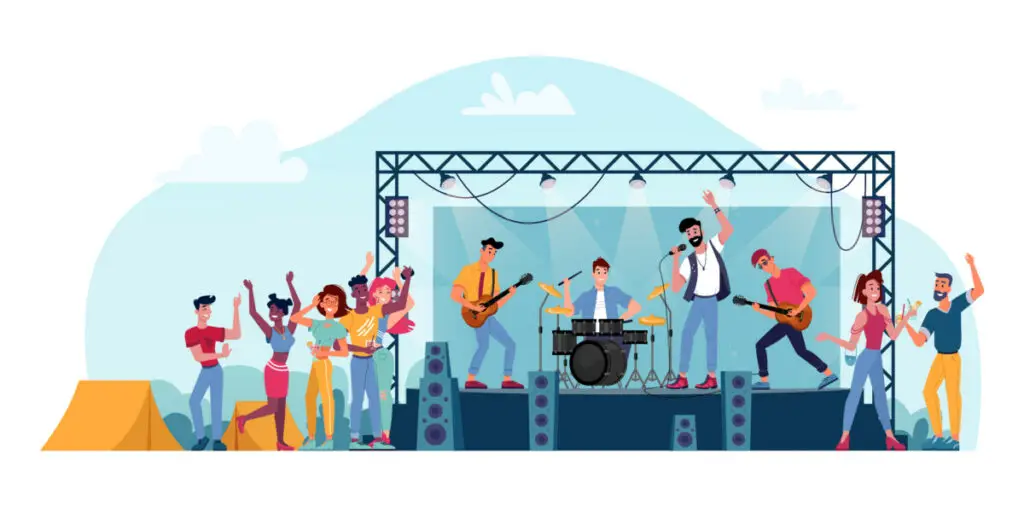
“In-house” refers to personnel, equipment, or services provided by the venue or promoter. This differs from equipment being outsourced to external vendors or contractors. An in-house sound engineer would be a staff member of the venue or promoter. Regardless, they are responsible for managing the sound system and equipment for a concert.
In-house services can often provide greater efficiency and consistency for concerts and events. After all, they are already familiar with the venue and its facilities. However, they may also be limited in their expertise or resources. External contractors have seen more venues, giving them a new perspective.
24. In-Ear Monitors
In-ear monitors, or IEMs, are an earpiece performers use during live concerts to monitor their performance and the sound mix. Unlike traditional stage monitors, which are on the floor or stage, IEMs fit into the performer’s ears. These monitors provide a personalized mix of various sound sources, such as instruments, vocals, and effects.
In-ear monitors can offer several advantages over traditional stage monitors, including better sound quality, reduced ambient noise, and greater mobility and flexibility on stage. They can also help protect the performer’s hearing by reducing exposure to loud sound levels. IEMs require careful calibration and management to ensure that the sound mix is appropriate for each performer, and that feedback and other issues are minimized during the performance.
25. Line Check
A line check is a brief test of the sound system and equipment. Staff members do this before the performers begin their soundcheck or rehearsal.
During a line check, each input channel of the mixing console is checked. This ensures that it receives a signal and that the sound levels are correct.
Line checks are typically conducted by the sound engineer or the performer’s technical crew. They correct any issues or problems with the sound system before the main performance.
Line checks are often conducted more quickly than a full sound check, which is a more comprehensive test of the sound system. A full sound check includes fine-tuning and adjustments to the sound mix.
Line checks are an important part of the technical preparation for a concert. They help ensure that the sound system is working properly and that the performance will proceed smoothly.
26. Load-Bearing Capacity
Load-bearing capacity is the maximum weight a structure or equipment can safely support. For example, this might include the following:
- Stages
- Rigging points
- Scaffolding
- Lighting trusses
- Speaker arrays
Load-bearing capacity is important when setting up concert stages and equipment. Exceeding the maximum weight limit can cause structural damage or collapse, resulting in serious injury or property damage.
Load-bearing capacity is found through careful engineering calculations and testing. Local building codes and safety standards regulate it.
Concert production teams and technical crews are responsible for ensuring that all equipment and structures are set up and used within their load-bearing capacity limits to ensure the safety of performers, crew, and audience members.
27. Load-In and Load-Out
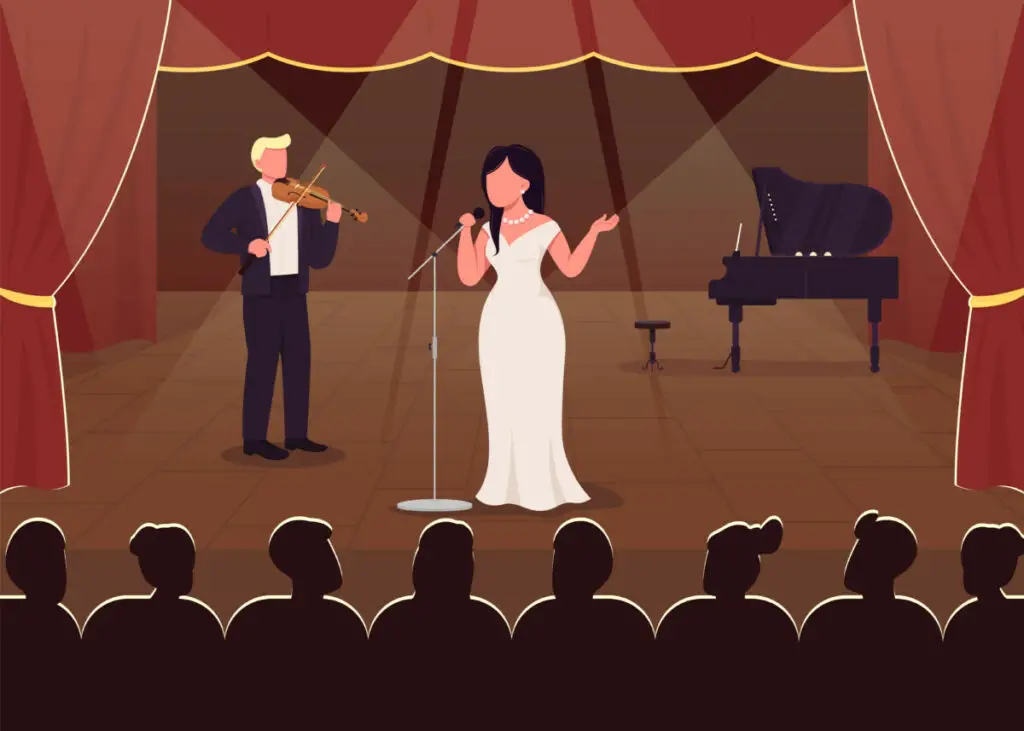
Load-in and load-out refer to setting up and taking down equipment and materials at the venue.
The load-in process involves bringing equipment, instruments, and other materials for setting up. This can involve carrying heavy equipment upstairs, setting up stages and rigging, and connecting sound and lighting equipment.
Load-out breaks down the equipment after the performance. This can include packing up instruments and equipment, dismantling stages and rigging, and loading everything onto trucks.
Load-in and load-out are time-consuming and physically demanding tasks. Crews require careful coordination and planning to handle things right.
Solid loading procedures are essential for a concert or event. They must be done safely and efficiently to ensure equipment is not damaged during transport.
28. Manifest
A manifest is a document that lists what’s being transported to the venue. This can include the following:
- Equipment
- Instruments
- Lighting
- Sound gear
- Costumes
- Everything else being shipped
Manifests ensure all equipment and materials are accounted for and transported safely. They can be used to identify and resolve any discrepancies that may arise while loading.
The production team or crew maintains manifests which may be shared with venue staff, transport companies, and other relevant parties. This keeps everyone involved in the production informed about what is being transported and its location.
29. Merchandise
Merchandise, often shortened to “merch,” refers to products sold to fans and attendees. Merch includes items like these:
- T-shirts
- Hats
- Posters
- CDs
- Vinyl records
- Anything else featuring an artist’s name, logo, or branding
Merchandising is an important source of revenue for performers. It can help to build and maintain a connection between fans and the artist.
Many fans enjoy collecting and wearing merchandise to support their favorite performers. Merchandise is often sold at a booth or table set up at the venue. It may be available before, during, and after the performance.
Some artists may also offer exclusive merchandise only available at certain concerts. This makes some merch valuable and sought-after collector’s items for fans.
30. Merch Rate
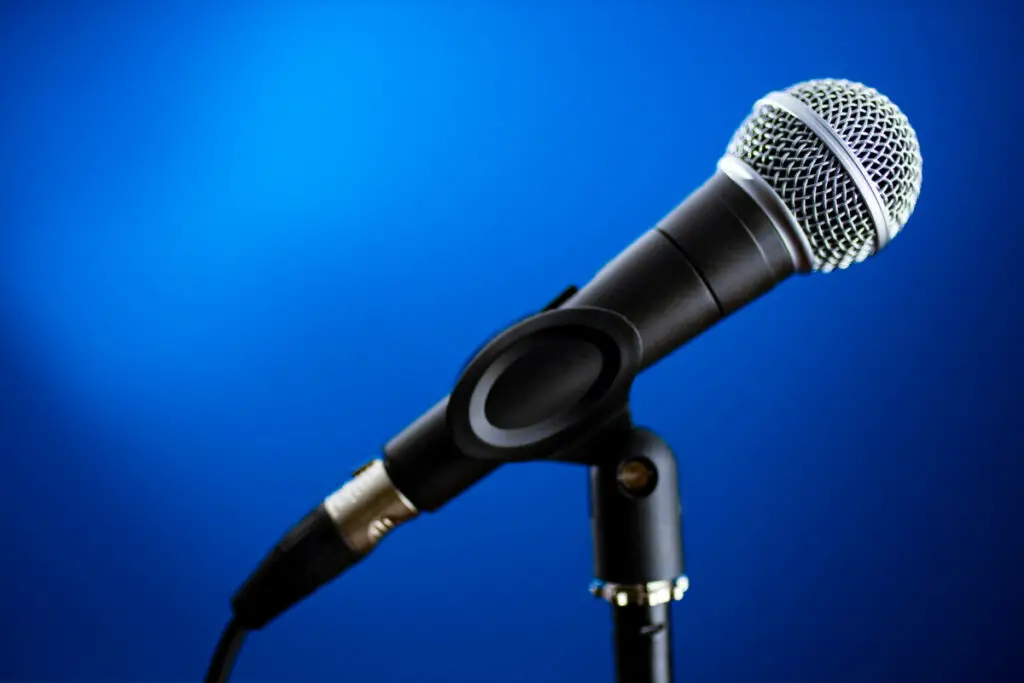
“Merch rate” is the rate of merchandise sales that the performer earns. This rate is negotiated as part of the contract between the artist and the promoter or venue. It can vary depending on several factors:
- The size and popularity of the artist
- Type and quality of the merchandise being sold
- The revenue and attendance of the concert
The merch rate has a significant impact on their earnings and profitability. It’s also important for promoters and venues, as a higher merch rate attracts lucrative acts.
The merch rate may be calculated as a percentage of the total sales. You can also measure it as a fixed fee per item sold, depending on the specific terms of the contract.
31. Middle Agent
A middle agent is an intermediate person or company between the artist and the promoter or venue. Middle agents provide various services:
- Negotiating contracts
- Arranging logistics
- Coordinating marketing and promotion efforts
They may also handle financial transactions and payments on behalf of the artist and provide support throughout the execution of the event.
Middle agents help facilitate profitable concerts bridging the gap between artists and promoters. They provide expertise in logistics, marketing, and finances.
However, middle agents can also increase the complexity and cost of organizing a concert, as their services typically come at a price. They may add an additional layer of communication and coordination that can create logistical challenges.
32. Mixer
A mixer is an audio equipment that combines and adjusts the various audio signals from those on stage. It is a control center for the audio system.
A good mixer lets the sound engineer adjust the volume, tone, and balance of different audio inputs in real-time. This can include adjusting the levels of individual instruments. Mixers add effects like reverb or delay, ensuring the sound mix is balanced.
Mixers range in size and complexity from small, portable units to large, multi-channel consoles for larger concerts. The sound engineer, or mixer operator, uses the mixer. They work closely with crew members to ensure the sound is optimized for the specific venue and audience.
33. Monitor
A monitor is a speaker or set of speakers providing sound to the performers on stage. This allows them to hear themselves and other performers more clearly.
Monitors are typically placed around the stage and can be adjusted in volume, tone, and balance. This helps them meet the specific needs of each performer.
In-ear monitors (see above) are a type of monitor that fits directly into the ear. These monitors provide more precise and customizable sound than traditional floor monitors.
Monitors create a successful performance, allowing performers to hear themselves and others.
The sound engineer or monitor technician sets up the monitors to create the desired sound mix. They work closely with the performers and other members of the technical crew to ensure that the sound is optimized for the specific venue and audience.
34. Mosh Pit
A mosh pit is a spot before the stage where fans dance, jump, and engage in energetic and aggressive movements. The mosh pit is typically characterized by physical activity. Audience members push and shove each other in time with the music.
Moshing is associated with punk, metal, and hardcore. It is seen as a way for fans to express their enthusiasm for the music and engage with other like-minded individuals.
While moshing can be an exciting and positive experience for some, it can also be dangerous and lead to injuries if not properly managed. As such, many venues and concert organizers have established guidelines or rules for moshing. Venues may have security personnel present to ensure the safety of both performers and audience members.
35. Opening Act
An opening act is a performer or group that performs before the main or headlining act. The opening act complements the style or genre of the headlining act. These performers may be selected based on popularity, stage presence, or other considerations.
Opening acts often warm up the audience and build excitement for the main event. They may be given a limited amount of time to perform, typically ranging from 15 minutes to an hour.
While opening acts may be less well-known than the headliner, they can provide an important opportunity for exposure and help build a fan base. Opening for a big star is typically a milestone for an artist or band’s career.
36. Promoter
A promoter is responsible for organizing and marketing a performance or event. The promoter books the venue, negotiates with the artist or band, handles ticket sales and marketing, and oversees the event’s logistics.
Promoters may be independent contractors or work for a larger organization, such as a concert production company or record label.
The success of a live concert or event is dependent on the promoter’s ability to effectively market the show. They also need the ability to manage the many logistical details involved. Promoters may also be responsible for managing the financial aspects of the event, such as negotiating performance fees and managing expenses. They may be compensated through a percentage of ticket sales or other performance-related revenue.
37. Production Skills
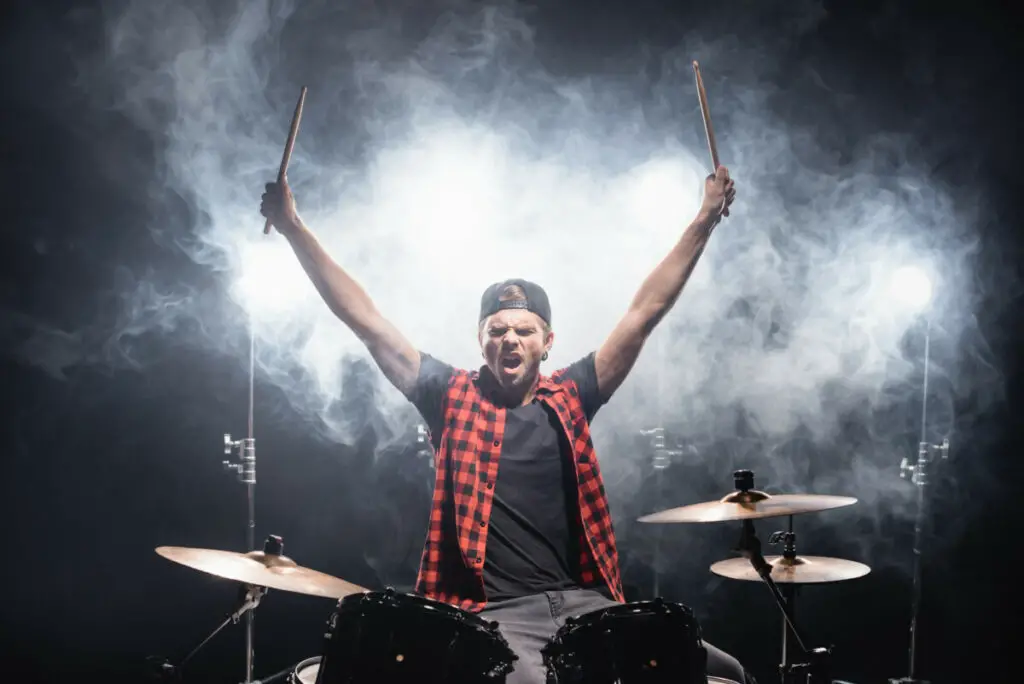
Production skills are the technical and logistical expertise to execute a successful performance. These skills may include the following:
- Sound engineering
- Lighting design
- Stage design
- Set construction
- Rigging
- Video production
- Other technical aspects of live performance.
These skills are critical to ensuring the concert runs smoothly, sounds good, and looks great. They involve complex coordination between a team of technical specialists, musicians, and performers.
Production skills are essential for creating an engaging and immersive concert experience for the audience. They are often a key factor in the success of a live event.
38. Proscenium Staging
Proscenium staging is a concert stage design where the stage is framed by a large arch or rectangular frame. This is known as the proscenium arch.
The audience is typically seated on one side of the arch, facing the stage. Meanwhile, the performance area is behind the arch.
This type of staging is common in traditional theater and concert venues. It allows for a clear separation between the performers and the audience, complex sets, and lighting effects.
The proscenium arch can also create a sense of depth and perspective on the stage. This makes it a popular choice for large-scale productions that require a grand and immersive visual experience.
39. Reserved Seating
Reserved seating is an arrangement where specific seats are set aside for ticket holders at a live concert. This contrasts with general admission, where seating is not assigned
Recall from our earlier definition, GA attendees can choose their own seats on a first-come, first-served basis. With reserved seating, ticket holders typically choose their seats at purchase. The venue gives them a map to get to their seat, sorted by different rows and sections.
Reserved seating is often used for large-scale concerts that need to sort many people. It also appeals to those who prefer a more structured seating arrangement. However, reserved seating can also be more expensive than general admission. It may limit flexibility regarding seating arrangements or last-minute changes.
40. Rider
A rider is a contractual document outlining the requirements of an artist for their appearance at a concert or event. The rider may include various details, such as these:
- Technical specifications for the performance
- Hospitality and accommodation requirements
- Catering preferences
- Other logistical details
The rider is negotiated between the artist and the promoter or event organizer. It is an essential part of the artist’s contract.
The purpose of the rider is to ensure that the artist’s needs are met and that they can perform to the best of their abilities. It also provides a clear and agreed-upon set of expectations for both parties.
Riders can be very specific and detailed. They may vary greatly depending on the artist and the type of performance.
41. Rigger
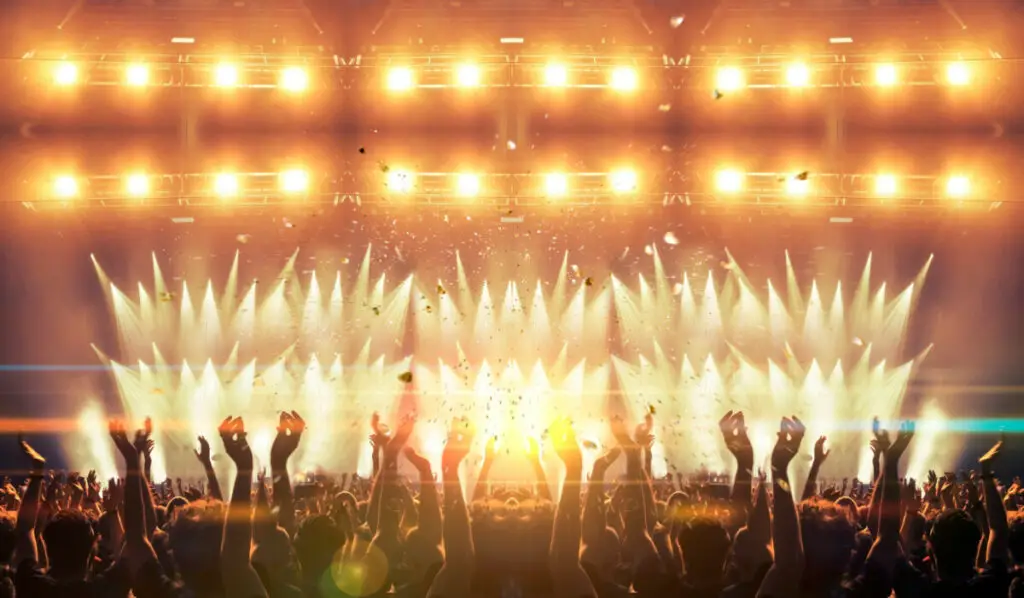
A rigger is a professional who installs and operates rigging equipment, which holds heavy loads. This may include rigging for the following:
- Lighting
- Sound
- Video
- Permanent stage elements
- Temporary structures (such as trusses and scaffolding)
Rigging is an essential part of many concerts and events. It allows for the safe and secure suspension of equipment, scenery, and performers above the stage or audience.
Riggers must be trained to use rigging equipment. They must have a deep understanding of physics, load-bearing capacities, and safety protocols to ensure that all rigging is installed and operated safely and effectively.
In many cases, riggers work closely with lighting and sound technicians. They also work with other members of the technical crew, to ensure that all show elements are coordinated and integrated seamlessly.
42. Rigging
Rigging refers to installing equipment and structures (see above) that support various elements of a live concert or event.
It allows equipment and performers to be positioned safely above the audience. Rigging is typically performed by professional riggers, who work closely with other members of the technical crew.
43. Roadie
A roadie is a member of a touring crew who works behind the scenes to set up, maintain, and break down equipment for a live concert or event.
Roadies are responsible for various tasks, including the following:
- Loading and unloading equipment
- Setting up and testing sound and lighting systems
- Coordinating with other technical crew members
Roadies are often required to work long hours, travel extensively, and perform physically demanding tasks. They play a vital role in the success of a live performance, ensuring that all technical aspects of the show are executed flawlessly and contributing to the overall experience of the audience.
44. Setlist
A setlist lists songs a performer or band plans to play during a live concert. When you hear a band talk about “playing a set,” this is what they mean.
The setlist is usually planned in advance but may be adjusted during the show depending on the audience’s reaction, the performers’ energy level, or other factors. Setlists can be a source of anticipation and excitement for fans, who often try to guess which songs will be included and in what order.
45. Settlement Sheet
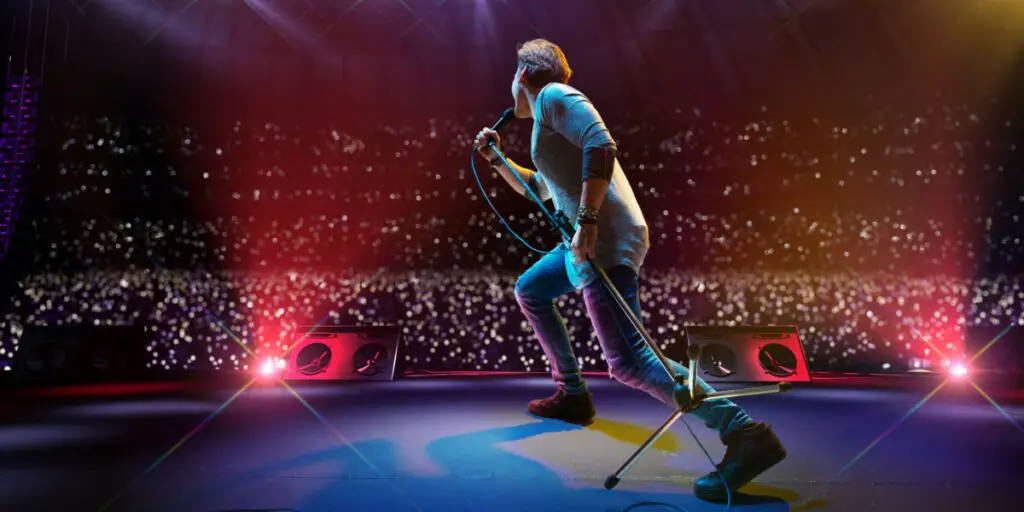
A settlement sheet outlines the financial details of a concert or live event. This includes the costs, revenues, and profits. You’ll also find information about the number of tickets sold, the ticket prices, any expenses related to the venue, production, and performers, and any additional income from merchandise or sponsorships.
The settlement sheet is usually prepared by the promoter or producer of the event and is reviewed and agreed upon by the performers and their representatives before payment is made. Settlement sheets are an important tool for tracking the financial success of a concert or live event and for ensuring that all parties are compensated fairly.
46. Soundcheck
The sound check is where musicians and sound technicians adjust the sound system and instruments in preparation for a live performance. It involves playing some noise to ensure that the levels of the instruments and vocals are balanced and the sound is appropriate for the venue.
A sound check is important because it ensures that the sound quality for the live show is optimal. With this, any issues can be identified and resolved before the performance begins. Sound checks happen several hours before the performance, and the promoter or the venue typically sets the time and duration.
47. Sound Engineer
A sound engineer manages sound quality during a live performance or recording. They handle the technical aspects, including setting up and operating the sound system, adjusting levels and frequencies, and ensuring the sound is balanced and clear.
Sound engineers may work for a venue or be hired to manage their sound for a short time. They may also work in recording studios, film, or TV production. Sound engineers have training and experience in audio engineering, acoustics, and music production.
48. Stage Diving
Stage diving is when a performer jumps off the stage and is carried by the crowd. The crowd passes the performer around, hopefully ending up back on the stage.
It is a popular form of crowd surfing and is often associated with punk, metal, and rock concerts. While stage diving can be a thrilling experience for performers and fans, it can also be dangerous. There is some potential for injury to the performer or crowd members. It is often discouraged or prohibited by concert venues and promoters.
49. Stage Left and Stage Right
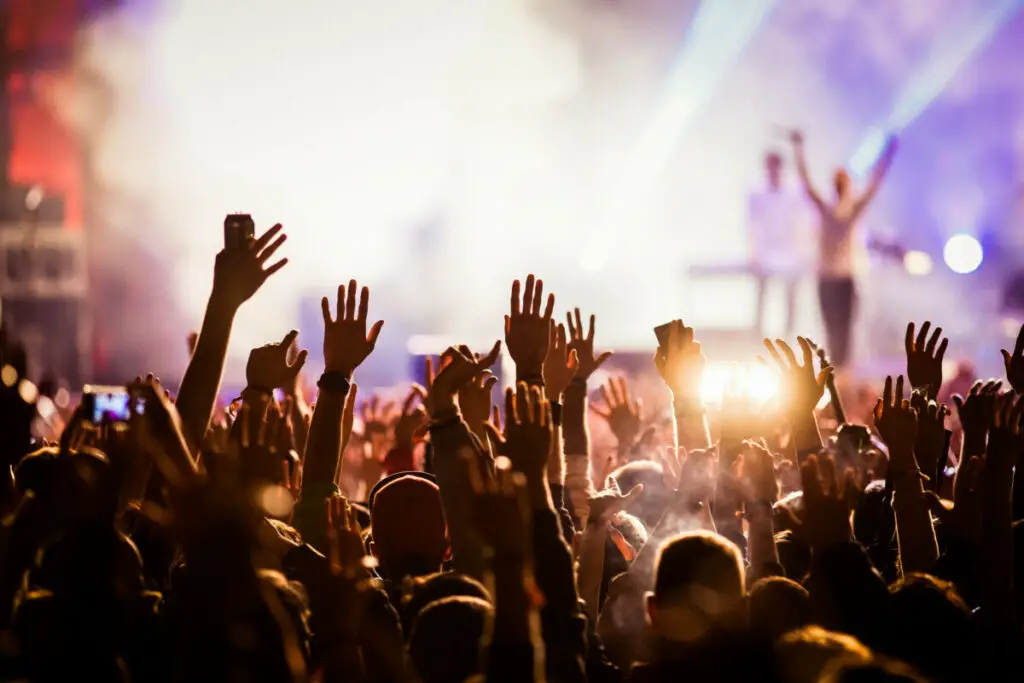
“Stage left” and “stage right” refer to the left and right sides of the stage from the perspective of a performer facing the audience. These terms are used by the production crew, performers, and event staff to coordinate movements and positioning. When referring to the stage from the audience’s perspective, the terms “stage left” and “stage right” are reversed.
50. Tour
A tour is a series of concerts by an artist or band at various venues.
Tours range from small, local shows to large-scale productions with multiple artists. The success of a tour may depend on factors such as the popularity of the artists, the quality of the performances, the quality of the production, and the effectiveness of the marketing and promotion efforts.
51. Venue
A venue is a location, such as a concert hall, theater, arena, stadium, or other space, where concerts, performances, or other public gatherings occur. A venue varies in size and may be indoor or outdoor, permanent or temporary. The choice of venue can affect the success and overall experience of the event.
52. Very Important Person (VIP)
A “very important person” or VIP in the concert industry has special privileges or access at an event due to their status. VIP tickets are sold to those willing to pay a premium.
VIP tickets include preferred seating, exclusive areas, meet-and-greets with the performers, or access to VIP lounges and hospitality. Alternatively, VIP guests may include celebrities, industry professionals, sponsors, or high-paying fans. Meanwhile, those who purchase VIP tickets just need deep pockets.
53. Will-Call Window

The will-call window at a concert venue is where guests can pick up pre-purchased tickets or those left under their names. It’s usually at the box office or near the venue’s entrance.
It is staffed by venue personnel who verify the identity of the ticket holder before issuing the tickets. The term “will call” indicates that the tickets are being held for the guest and can be picked up on the event day.
54. Wings
Wings are the areas offstage to the left and right of the performing area concealed from the audience’s view by curtains or other scenic elements. Performers use the wings to enter and exit the stage. They are also used for costume changes, prop storage, and technical equipment.
The term “fly space” refers to the area above the stage where the scenery, lighting, and other objects can be suspended and flown in and out of the performing area.


